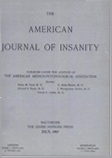PROTRACTED SHOCK: ITS CAUSE AND ITS PREVENTION
Abstract
(1) An attempt has been made to determine whether or not the medullary phase always precedes protracted shock. The shocks were recorded on the charts designed by the writers and published by Ross and Malzberg. It was shown that no protracted shock occurs unless the medullary phase had been reached.
(2) In order to determine whether or not the persistence of medullary signs is responsible for protracted shock, an arrangement was made by which the shocks of the female group were terminated without delay as soon as the first signs of the medullary phase were recorded, while in the male group medullary signs were allowed to develop fully and to persist for some time (from one-quarter to three-quarters of an hour).
(3) In the female group, in a total of 520 shocks, the medullary phase was reached 181 times. In this group no protracted shock occurred. In the male group, in a total of 995 shocks, the medullary phase was reached 237 times and was allowed to persist. Thus 18 protracted shocks resulted. Protracted shock occurred in the male group in 1.8 per cent of all shocks and in 7.8 per cent of shocks in which the medullary phase had been reached and allowed to persist.
(4) It is concluded, therefore, that protracted shock occurs only in shocks where the medullary phase was allowed to develop fully and to persist for some time. However, this relatively rare occurrence in such shocks (7.8 per cent) shows that there are other factors also responsible for protracted shock. These factors were not elicited.
(5) Two explanations of protracted shock are offered. In one, emphasis is placed on the disturbed function of the medullary nuclei; while in the other the continued carbohydrate deprivation of the cortical cells is considered a chief factor. The hypothetical character of such explanations is stressed.
(6) The therapeutic value of protracted shock is not discussed.
(7) Measures are suggested that appear to prevent the occurrence or reduce the severity of protracted shock. However, no dependable methods have been found to control severe protracted shock once it has developed, or to cope with its dangers.
Access content
To read the fulltext, please use one of the options below to sign in or purchase access.- Personal login
- Institutional Login
- Sign in via OpenAthens
- Register for access
-
Please login/register if you wish to pair your device and check access availability.
Not a subscriber?
PsychiatryOnline subscription options offer access to the DSM-5 library, books, journals, CME, and patient resources. This all-in-one virtual library provides psychiatrists and mental health professionals with key resources for diagnosis, treatment, research, and professional development.
Need more help? PsychiatryOnline Customer Service may be reached by emailing [email protected] or by calling 800-368-5777 (in the U.S.) or 703-907-7322 (outside the U.S.).



